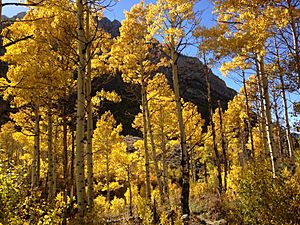Quaking aspen facts for kids
The quaking aspen is a special kind of tree. The name "quaking aspen" refers to two main species:
- Populus tremuloides, which grows naturally in North America.
- Populus tremula, also known as the European trembling aspen.
These trees are famous for their leaves that seem to "quake" or tremble in the slightest breeze. This happens because their leaf stems are flat, allowing the leaves to move easily.
Contents
What Makes Aspens Special?
Aspens are unique because of how they grow and spread. Unlike many trees that mostly grow from seeds, aspens mostly spread using their roots.
Spreading by Roots
Aspen trees send out special shoots called suckers from their roots. These suckers can pop up from the ground far away from the parent tree, sometimes as far as 40 meters (about 130 feet)!
Forming Clonal Colonies
When these suckers grow, they form what are called clonal colonies. This means that all the trees in a colony are actually genetically identical. They are all part of the same single organism, connected by a huge underground root system. It's like one giant tree with many trunks!
The Pando Clone
One of the most famous examples of a clonal colony is called "Pando." It's located in Utah, USA, and is believed to be one of the largest and oldest living things on Earth. Pando covers over 100 acres and has tens of thousands of individual "trees" that are all connected. Scientists think it could be thousands of years old!
Where Do Quaking Aspens Live?
Quaking aspens are found in many different places.
North American Aspen
The Populus tremuloides is one of the most common trees in North America. It grows from Canada all the way down to Mexico. You can find it in many different environments, from high mountains to flat plains.
European Trembling Aspen
The Populus tremula is found across Europe and parts of Asia. It also likes cool, moist places and can grow in various types of forests.
Life Cycle of an Aspen
While aspens can produce seeds, their main way of reproducing and spreading is through their root system.
Seeds and Catkins
In spring, aspen trees produce fuzzy, dangling flowers called catkins. These catkins contain tiny seeds that can be carried by the wind. However, for a new aspen tree to grow from a seed, the conditions need to be just right, which doesn't happen very often.
Growing from Suckers
Most new aspen trees come from the suckers that grow from the roots of existing trees. This allows them to quickly spread and take over areas, especially after events like forest fires. The roots can survive underground and then send up new shoots, helping the forest recover.
Aspens Through the Seasons
Quaking aspens are beautiful trees that change a lot throughout the year.
Spring and Summer
In spring, the trees get their fresh, green leaves. The leaves are round or heart-shaped with small teeth along the edges. In summer, the green leaves provide shade and food for many animals.
Amazing Fall Colors
Aspens are most famous for their stunning fall colors. Their leaves turn a brilliant golden yellow, sometimes even orange or red, before falling off for winter. When you see a whole mountainside covered in these bright colors, it's a truly amazing sight! Different parts of a clonal colony might even turn different colors, creating a beautiful patchwork.
Importance of Aspen Trees
Aspens play a very important role in their ecosystems.
Home for Wildlife
Many animals depend on aspen trees. Deer, elk, and moose eat their leaves and bark. Birds build nests in their branches, and small mammals find shelter among their roots. Even beavers use aspen wood to build their dams and lodges.
Helping the Environment
Aspens are often among the first trees to grow back after a forest fire. Their ability to sprout from roots helps to quickly re-establish forests. They also help to stabilize soil and prevent erosion.
Images for kids
-
Clonal colonies of different autumnal colors on a mountainside in the Matanuska Valley in Alaska
See also
 In Spanish: Álamo temblón para niños
In Spanish: Álamo temblón para niños







